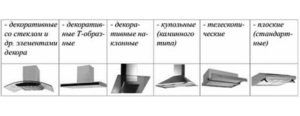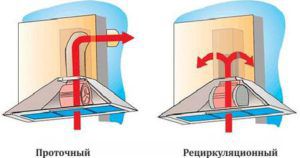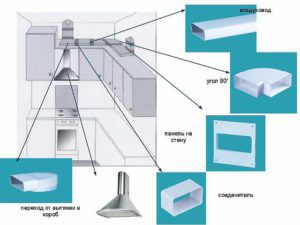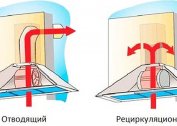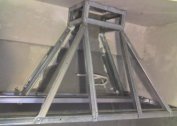For a comfortable stay in the kitchen and cooking, you must perform a hood. It will provide air purification and fat removal during cooking. Today, hoods for the kitchen are presented in a huge assortment, and their installation is possible with your own hands. The main thing is to perform all the work correctly, in which case the system will work at the highest level for a long time.
Classification of cooker hoods by the principle of action
Hoods that can be purchased today are divided into two large groups according to the principle of operation:
- outflow;
- recirculating.
Hoods of the first group operate on the principle of removing exhaust air from the premises. The performance of this option is very high. The device of such a device is possible only if there is a ventilation shaft or a special hole in the wall of a private house. It is important that there is a fan in the system that will conduct air through the channel.
When the device of the hood of the second type does not need a ventilation shaft. They absorb the exhaust air, pass through a filter system and return it to the room. This variety is less effective, it is better to use it in small rooms. Such a hood may be hidden in the furniture and will not spoil the appearance of the interior.
When choosing a device, it is necessary to consider not only its appearance, but also performance. Therefore, before buying, you should accurately calculate the area of the room. In addition, when choosing it is worth paying attention to the control system. The control panel can be on buttons or touch. More expensive models may have a remote control system.
An important point that you should pay attention to is the backlight. Its presence has an effect on comfortable cooking. In modern hoods, it can be different.
Highlights of a kitchen hood
Types of designs of exhaust systems have their own characteristics. This is important to consider during installation.
- Equipment that carries out the exhaust and recirculation of air must have access to an external ventilation system. When performing work, special attention should be paid to calculating the diameter of the duct, it should be within 12-15 cm. The narrowing of the channel is unacceptable, this can negatively affect performance. It is also worth minimizing the number of turns of the duct. You can use a square or round pipe to set up the system, and it is recommended that you choose smooth options rather than corrugated ones.
- Hoods that work only in air recirculation mode do not need to be connected to the ventilation shaft. They capture air, pass it through a filter system and again take it out to the room. Correctly connecting a device of this type is quite simple, the main thing is to follow some recommendations.
The installation method is also influenced by what type of equipment is used: built-in or mounted.
Inventory that will be required when performing work
Before you make the hood in the kitchen, you need to prepare tools and materials. When purchasing an extractor hood, dome, or other type of kit, there are already some elements in the kit, but for installation you will need to purchase additional elements.
In order to complete all the work it is also worth purchasing:
- ventilation duct - this can be a pipe with a round or square cross section. However, it can be smooth or corrugated.The choice depends on personal preferences and features of the room;
- grill for vent hole. It performs a decorative function;
- special mounts for the ventilation duct.
As for the tool, you will need a screwdriver and a puncher. You also need to use a Phillips screwdriver. Roulette and a simple pencil are used for marking. To prepare the elements of the required length, you can use a hacksaw, depending on the material from which the channel is made. Having at hand all the necessary materials and tools, all work can be done in a very short time.
Phased work
Before proceeding with installation work, it is necessary to carry out calculations. Each type of hood should be located at different heights. Above the electric stove, the appliance is located at a height of 65 to 75 cm. If the stove is gas, then the height of the hood must be increased to 75-85 cm. These standards must be taken into account in order to correctly perform the installation of the exhaust system.
Standards are aimed at providing comfortable cooking conditions and preventing fire hazard situations.
Regardless of whether a hood hood or another is used, all the work can be divided into three main stages:
- fastening the hood to the wall;
- connecting the device to the ventilation system;
- connection to the mains.
Mounting the hood over the stove
Regardless of which hood has been selected, it should be as securely mounted on the wall as possible. To do this, use dowels of suitable length. Mounting must be carried out at the correct height. If the hood is placed too low, the appliance may be damaged by the hot air that the stove creates. If the distance is too large, then the vapor during cooking will disperse throughout the room, not reaching the hood.
Further work on installing the hood
After the hood is mounted on the wall, you can proceed with further work. If the hood involves air out, then it is worth connecting it to the ventilation shaft. In this case, special pipes must be used. They can be made with various materials. Today, the most popular option is plastic products. They are very practical and have an attractive appearance. Such channels can be smooth and corrugated. It is worth giving preference to even options, since they create less noise during operation and do not impede the passage of air.
All joints of plastic channels must be sealed with silicone sealant.
This will prevent the ingress of exhaust air into the room. Fix the plastic channel to the wall with the help of special clamps.
Mains connection
It will be correct to make a separate outlet for connecting the hood in the kitchen. Its location should be foreseen at the stage of repair work. This will hide all the wires in the wall, and they will not spoil the appearance of the room. If the socket was not installed initially, it can be installed later. In this case, the wire can be hidden under the kitchen set or simply closed using special plastic elements.
A separate power point allows you to use the hood, regardless of how many appliances are turned on in the kitchen at the same time. Carrying out all the work, it is worth paying attention to the wires and auxiliary elements.
Features of installing hoods
The installation of the built-in hood has some differences that are important to be aware of. In order to properly install such a device, you first need to determine the height of its location. Unlike the hood hood, the built-in version is not attached to the wall, but to the kitchen furniture.In this way, the appliance is practically invisible and it does not violate the integrity of the appearance of the kitchen set. Thus, not only a flow-type hood can be attached, but also recirculation options.
This method is most often used in small kitchens. Since the power of the device is much lower than that of the hood hoods. The final stage of installation is a protective casing for the air duct. Before that, it is worth checking the operability of the entire system.
Hood performance
In order to maintain the functionality of the kitchen hood for a very long time, it is important to properly and timely clean. It is important to conduct a general cleaning of the entire device once every six months. Today, there are various tools that allow you to remove fumes and a layer of fat without much difficulty. During general cleaning, it is recommended to disassemble the system and view all the details.
The recirculation hood must also be cleaned. At the same time, it is worthwhile to replace all filtration systems. A dirty filter is not able to clean the air efficiently, so it is important to carry out a timely replacement.
